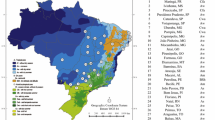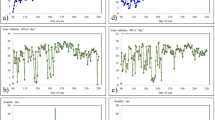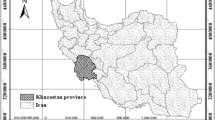Abstract
Sugarcane is a crop of major importance for Brazil. Many of the sugarcane fields are located in the center-south of the country, where sugarcane is grown as a rainfed crop. However, it has recently also expanded into marginal areas where irrigation is required. As water is less available during the dry season in these areas, a study was conducted to evaluate the performance of the DSSAT CSM-CANEGRO model under operational conditions in Brazil, and to determine the benefits of different complementary irrigation strategies for increasing yield in different regions in the country. Two different datasets were used to evaluate the performance of DSSAT CSM-CANEGRO in the most traditional sugarcane areas in Brazil, where the model was used to simulate plant cane crop yield. Further, the crop model was used to simulate sugarcane yield under different climatic conditions, in order to assess its sensitivity under real conditions. Additionally, five different complementary irrigation scenarios were simulated, with a fixed irrigation depth of 30 mm, and with the number of irrigations ranging from zero (rainfed crop) to five (150 mm per cycle), during the dry season at each location. The CSM-CANEGRO presented a satisfactory performance to estimate the operational sugarcane yield in different environments, with an acceptable root mean square error of about 15 t ha−1. Based on the simulations with the different complementary irrigation strategies, it was possible to understand that the 12-month plant cane’s response to water depends on amounts of water, soil type and planting date. The highest yield increments were observed in the sandy soils, where the water deficit is more intense. However, for the majority of the locations evaluated, the average yield increment for the irrigation depth applied, between 30 and 150 mm, was no greater than 30 %, with the exception of Petrolina, PE, which has a semi-arid climate.








Similar content being viewed by others
References
Adami, M., M.P. Mello, D.A. Aguiar, B.F.T. Rudorff, and A.F.A. Souza. 2012. Web platform development to perform thematic accuracy assessment of sugarcane mapping in South-Central Brazil. Remote Sensing 4: 3201–3214. doi:10.3390/rs4103201.
BRASIL. Ministério da Agricultura, Pecuária e Abastecimento. Zoneamento Agrícola de Risco Climático. Retrieved July 20, 2014, from http://www.agricultura.gov.br/politica-agricola/zoneamento-agricola.
Camargo, A.P., and P.C. Sentelhas. 1997. Avaliação do desempenho de diferentes métodos de estimativas da evapotranspiração potencial no Estado de São Paulo, Brasil. Revista Brasileira de Agrometeorologia, Santa Maria 5(1): 89–97.
Cardozo, N.P., and P.C. Sentelhas. 2013. Climatic effects on sugarcane ripening under the influence of cultivars and crop age. Scientia Agricola, Piracicaba 70(6): 449–456.
Carvalho, C.M., H.M. Azevedo, J. Dantas Neto, C.H.A. Farias, C.T.S. Silva, and R.R. Gomes Filho. 2009. Rendimento de açúcar e álcool da cana-de-açúcar submetida a diferentes níveis de irrigação. Revista Brasileira de Ciências Agrárias, Recife 4: 72–77.
Cintra, J.E., G.H. Ferreira, and R.P.C. Brasil. 2008. Viabilidade da irrigação suplementar na fase inicial de desenvolvimento da cana-de-açúcar (Saccharum ssp.) em regiões com déficit hídrico. Nucleus, Ituverava, Edição Especial 1: 111–119. doi:10.3738/1982.2278.141.
Coelho, R.D., J.A. Lelis Neto, and A.C. Barros. 2009. Cana irrigada produz mais, mas custo de produção aumenta. In: Agrianual 2009: anuário da agricultura brasileira. FNP CONSULTORIA & COMÉRCIO, 240–2042. São Paulo.
CONAB. 2014. Acompanhamento da Safra Brasileira: Cana-de-açúcar, Safra 2014/2015, primeiro levantamento. Brasília, p. 19.
Da Silva, A.P.M., J.A.M. Bono, and F.A.R. Pereira. 2014. Aplicação de vinhaça na cultura da cana-de-açúcar: Efeito no solo e na produtividade de colmos. Revista Brasileira de Engenharia grícola e Ambiental, Campina Grande 18(1): 38–43.
Glover, J., and J.S.G. McCulloch. 1958. The empirical relation between solar radiation and hours of sunshine. Quartely Journal of the Royal Meteorology Society 84: 172–175.
Hargreaves, G.H. 1994. Simplified coefficients for estimating monthly solar radiation in North America and Europe, 12. Logan, Utah: Departmental Paper, Department Biology and Irrigation Engineering, Utah State University.
IBGE. 2014. Banco de Dados Agregados. Sistema IBGE de Recuperação Automática—SIDRA. Retrieved July 20, 2014, from http://www.ibge.gov.br.
Inman-Bamber, N.G. 1991. A growth model for sugarcane based on a simple carbon balance and the CERES-Maize water balance. South African Journal of Plant and Soil, Bethlehem 8(2): 93–99.
Inman-Bamber, N.G. 2004. Sugarcane water stress criteria for irrigation and drying off. Fields Crops Research, Amsterdam 89: 107–122.
Inman-Bamber, N.G., and D.M. Smith. 2005. Water relations in sugarcane response to water deficits. Field Crops Research, Amsterdam 92: 185–202.
INPE. 2014. Divisão de Sensoriamento Remoto. CANASAT: mapeamento da cana via imagens de satélites de observação da terra. São José dos Campos. Retrieved June 2, 2014, from http://www.dsr.inpe.br/laf/canasta.
Jiang, Z.P., Y.R. Li, G.P. Wei, Q. Liao, T.M. Su, Y.C. Meng, H.Y. Zhang, and C.Y. Lu. 2012. Effect of long-term vinasse application on physico-chemical properties of sugarcane field soils. Sugar Tech 14(4): 412–417.
Jones, C. A., M. K. Wegener, J. S. Russel, I.M. McLeod, and J.R. Williams. 1989. AUSCANE, Simulation of Australian sugarcane with EPIC. Division of Tropical Crops and Pastures. Canberra: CSIRO (Tech. Paper 29).
Keating, B.A., M.J. Robertson, R.C. Muchow, and N.I. Huth. 1999. Modeling sugarcane production system I. Development and performance of the sugarcane module. Field Crops Researcher, Amsterdam 61(3): 253–271.
Liu, D.L., and G. Kingston. 1995. QCANE: A simulation model of sugarcane growth and sugar accumulation: QCANE. In: Research and modeling approaches to assess sugarcane production opportunities and constraints, workshop proceedings, ed. Robertson, M.J., 25–29, University of Queensland, St. Lucia, Brisbane.
Loarie, S.R., D.B. Lobell, G.P. Asner, Q. Mu, and C.B. Field. 2011. Direct impacts on local climate of sugar-cane expansion in Brazil. Nature Climate Change 1(2): 105–109.
Marin, F.R., P.J. Thorburn, D.S. Nassif, L.G. Costa, A.S. Rezende, and A.S. Andrade Jr. 2013. Evaluation of APSIM-SUGAR and DSSAT-CANEGRO for widely grown Brazilian sugarcane cultivar. In: Proceedings on congress of international society of sugarcane technologists, p. 28, São Paulo.
Monteiro, L.A., and P.C. Sentelhas. 2013. Potential and actual sugarcane yields in Southern Brazil as a function of climate conditions and crop management. Sugar Tech. doi:10.1007/s12355-013-0275-0.
Nassif, D.S.P., F.R. Marin, W.J.P. Filho, R.S. Resende, and G.Q. Pellegrino. 2012. Parameteterization and evaluation of the DSSAT/Canegro model for Brazilian sugarcane varieties. Pesquisa Agropecuária Brasileira, Brasilia 47: 311–318.
Oliveira, E.C.A., F.J. Freire, A.C. Oliveira, D.E.S. Neto, A.T. Rocha, and L.A. Carvalho. 2011. Produtividade, eficiência de uso da água e qualidade tecnológica de cana-de-açúcar submetida a diferentes regimes hídricos. Pesquisa Agropecuária Brasileira, Brasília 46: 617–625.
Singels, A., M. Jones, and M. Van Der Berg. 2008. DSSAT v.4.5 CSM-CANEGRO: Sugarcane plant module; scientific documentation. Mount Edgecombe: International Consortium for Sugarcane Modeling. South African Sugarcane Research Institute, p. 34.
Villegas, F.D., O.H. Daza, J.W. Jones, and F.W. Royce. 2005. CASUPRO: An industry-driven sugarcane model. ASAE paper no. 053025. ASAE, St. Joseph, MI.
Wallach, D., D. Makowski, and J.W. Jones. 2006. Working with dynamic crop models: Evaluation, analysis, parameterization and applications, 449. Amsterdam: Elsevier.
Willmott, C.J. 1981. On the validation of models. Physical Geography 2: 184–194.
Author information
Authors and Affiliations
Corresponding author
Rights and permissions
About this article
Cite this article
dos Santos Vianna, M., Sentelhas, P.C. Performance of DSSAT CSM-CANEGRO Under Operational Conditions and its Use in Determining the ‘Saving Irrigation’ Impact on Sugarcane Crop. Sugar Tech 18, 75–86 (2016). https://doi.org/10.1007/s12355-015-0367-0
Received:
Accepted:
Published:
Issue Date:
DOI: https://doi.org/10.1007/s12355-015-0367-0




